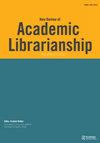Engaging Students in Academic Library Design: Emergent Practices in Co-Design
IF 2.3
Q2 INFORMATION SCIENCE & LIBRARY SCIENCE
引用次数: 3
Abstract
Abstract This article explores academic libraries that have gone beyond using the traditional survey or focus group methods of soliciting student input, specific to library design projects. The goal for each library was to engage students in space design projects in innovative and hands-on ways that would maximise the potential for gaining their design input towards the creation of improved and enhanced library spaces. The successful co-design practices are further contextualised by analysing the strategies employed by several academic libraries for engaging students in library design or redesign projects. Key trends, approaches, and emergent practices come into focus as they pertain to student input opportunities. By studying examples of student co-design in academic library design projects, several themes emerge as ingredients for reaching – and keeping – users engaged with library design. Importantly, students must feel that their commentary is valued and that their input is evident in the final design.让学生参与高校图书馆设计:联合设计中的新兴实践
摘要本文探讨了学术图书馆在图书馆设计项目中超越了传统的调查或焦点小组方法来征求学生意见。每个图书馆的目标是以创新和动手的方式让学生参与空间设计项目,最大限度地发挥他们的设计投入潜力,创造改进和增强的图书馆空间。通过分析几所大学图书馆为吸引学生参与图书馆设计或重新设计项目而采用的策略,进一步将成功的联合设计实践置于背景之中。关键趋势、方法和新兴实践因与学生投入机会有关而成为焦点。通过研究学术图书馆设计项目中学生共同设计的例子,几个主题成为接触并保持用户参与图书馆设计的要素。重要的是,学生必须感觉到他们的评论是有价值的,他们的投入在最终设计中是显而易见的。
本文章由计算机程序翻译,如有差异,请以英文原文为准。
求助全文
约1分钟内获得全文
求助全文
来源期刊

New Review of Academic Librarianship
Social Sciences-Library and Information Sciences
CiteScore
3.40
自引率
0.00%
发文量
20
 求助内容:
求助内容: 应助结果提醒方式:
应助结果提醒方式:


